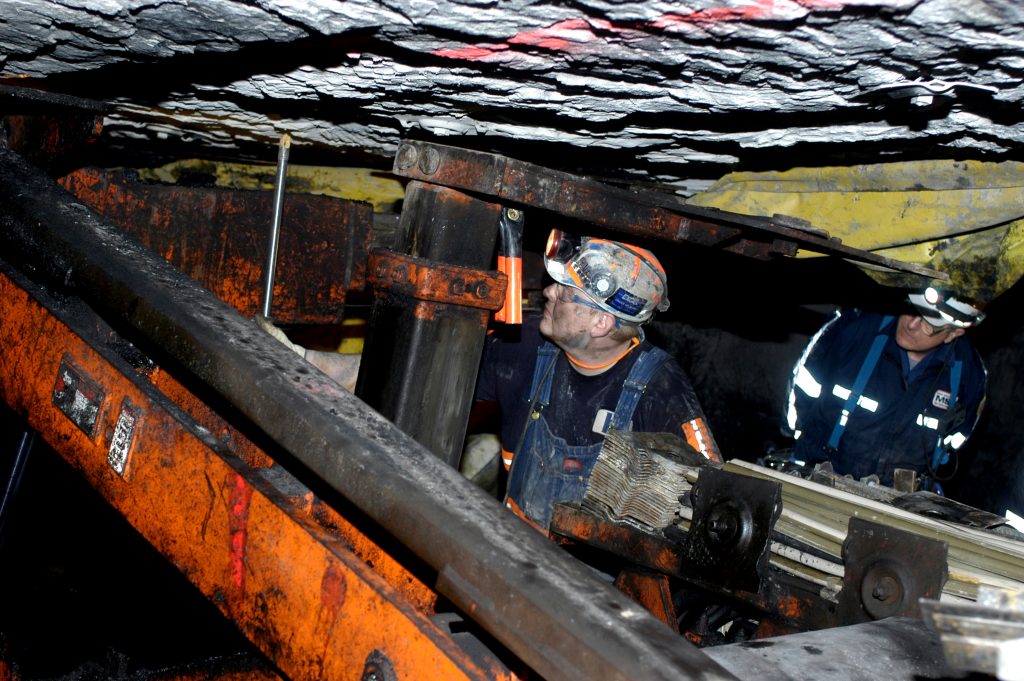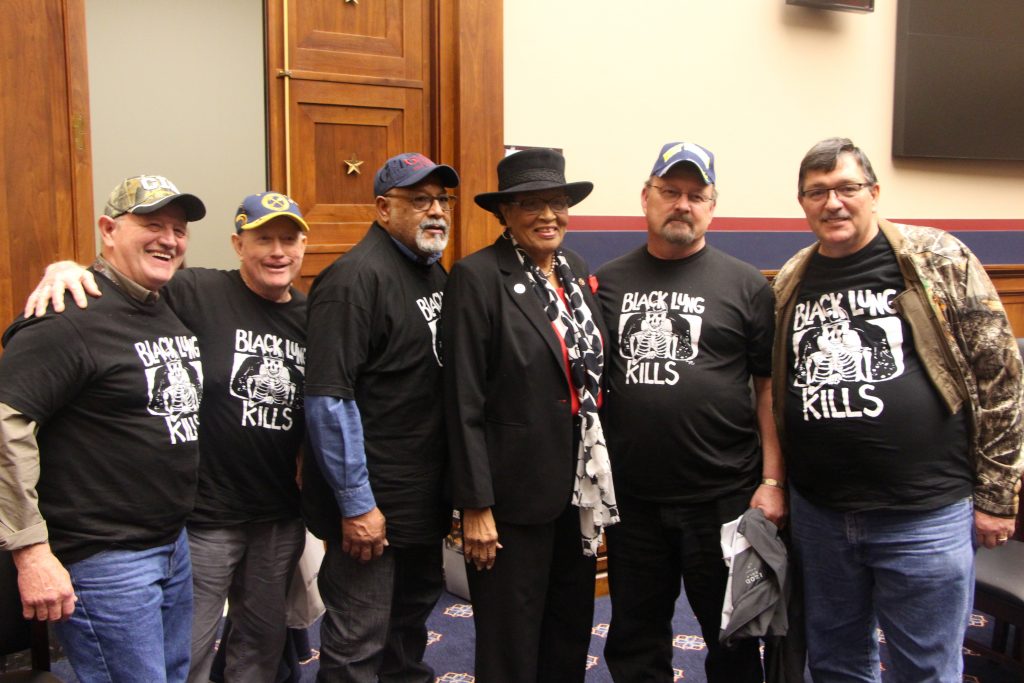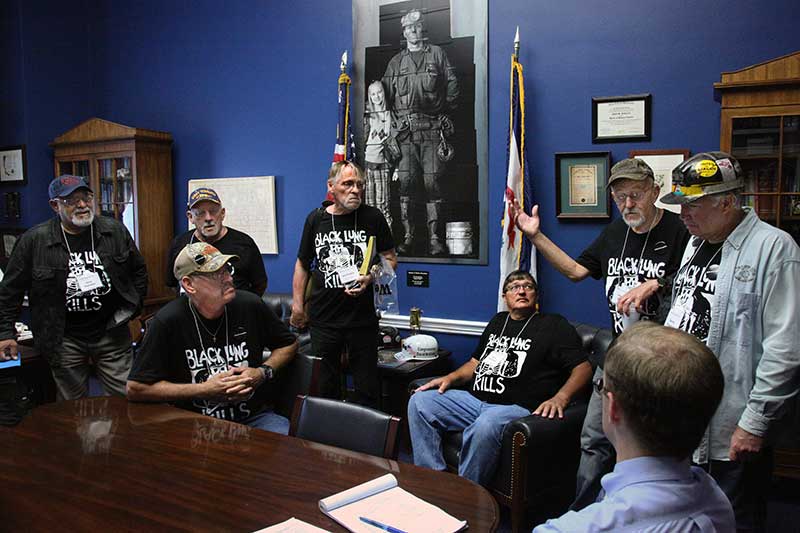Front Porch Blog
 Special to the Front Porch: Richard Miller is a former congressional staffer and served as the Labor Policy Director for the Committee on Education and Labor. (This was initially posted on Confined Space, a newsletter of workplace safety and labor issues.)
Special to the Front Porch: Richard Miller is a former congressional staffer and served as the Labor Policy Director for the Committee on Education and Labor. (This was initially posted on Confined Space, a newsletter of workplace safety and labor issues.)
This three-part guest blog examines the lengths coal companies will go to in order to evade their obligations to miners who develop black lung while working for them. Part I explained black lung and the benefit system in place for miners with the disease. Part II below discusses how companies short-change that system. Part III examines potential solutions.

Putting roof bolts in at the Coalburg Mine in West Virginia.
Dodging liability
Congress stated clearly that coal operators, instead of taxpayers, would shoulder the cost of black lung when it set up the Black Lung Trust Fund. The trust fund was intended to be a backstop for miners rather than a means for coal operators to underinsure their liabilities.
But over the past decades, many self-insured coal operators have perfected the art of dodging liability when it comes to coughing up (pardon the expression) the money to pay for black lung benefits,
This turned the purpose of the trust fund on its head.
According to the Government Accountability Office, instead of the trust fund serving as an emergency backup, it became the means by which a number of self-insured coal operators have cleverly offloaded around $1 billion in their liabilities through bankruptcy. These operators were able to shift more than 90% of their black lung liability to the trust fund, while in some cases reserving as little as 3% to cover the cost of claims.
For example, the Labor Department authorized Alpha Natural Resources, once one of the largest coal operators in the country, to post only $12 million in collateral for its self-insured liabilities. Yet, when Alpha filed for bankruptcy in 2015, nearly $500 million in black lung liabilities were transferred to the trust fund, according to the GAO. That means that Alpha was bailed out through bankruptcy while posting a mere 3% in collateral.

Gary Hairston and other members of the Black Lung Association with U.S. Rep. Alma Adams at a 2021 oversight hearing on self-insurance.
Gaming the Department of Labor
But failing to reserve enough money to cover black lung benefits is only one way for coal operators and Wall Street to game the system. Another way is to transfer these liabilities to a spin-off company, which, when it files for bankruptcy, makes the liabilities disappear.
Peabody Coal, for example, spun-off a new coal company out of its eastern U.S. mines in 2007 and saddled the new company with an insurmountable burden of black lung, pension and health care liabilities, but with far too few assets to pay the bills. This new, underfunded enterprise was named Patriot Coal.
Through a two-step process — (1) a spin-off followed by (2) an inevitable bankruptcy (Patriot declared bankruptcy in 2015) — Peabody jettisoned decades of black lung liabilities from their balance sheet. Although Patriot and the United Mine Workers of America contended Peabody’s spin-off was a fraudulent conveyance, in the end the Labor Department was left holding the bag to the tune of nearly a quarter billion dollars in black lung liabilities.
S&P Global reported:
“With the spinoff, Peabody rid itself of about $600 million of retiree-healthcare liabilities, along with hundreds of millions of dollars of other liabilities, including environmental-reclamation obligations and black-lung benefits.”
The UMWA explained in their April 19, 2023, comment letter to the Labor Department that:
“Patriot inherited only 13% of the parent company’s coal reserves. However, according to one executive, the spin off meant that ‘our retiree, health care liability and related expenses will be reduced by about 40%.’ and added ‘that workers’ compensation liability will be cut by nearly 90%.’ As many as 13 self-insured subsidiaries were spun out of Peabody into Patriot. Patriot also acquired three operators from Arch Coal that had self-insured liabilities.”
The Patriot boondoggle wasn’t a big surprise: more like that bad dream where the train is bearing down on you, but your feet are stuck in molasses.
Even when the Labor Department periodically updates operators’ required collateral levels, the operators are able to kick the can down the road by filing appeals that languish for years in the Labor Department. For example, the Labor Department had seen Patriot’s bankruptcy on the horizon in 2014 — a year before Patriot declared bankruptcy — and requested that Patriot increase its self-insurance collateral from $15 million to $80 million.
Patriot appealed. But the Labor Department had no quick procedure to deal with appeals, so in the eight months while the appeal was languishing, Patriot filed for bankruptcy, and eventually transferred $230 million in black lung benefit liabilities to the trust fund. The $15 million in collateral amounted to only 6% of what was needed to fund their black lung liability, according to the GAO. This was a government bailout engineered through a bankruptcy.

Coal miners meet with Congress members to press for black lung health benefits. Photo by Earl Dotter
Gaming the bankruptcy system: Three easy steps to escape liability
Professional Wall Street creditors aren’t dumb. They’re rich. And there’s a reason.
In this case, they have developed a clever workaround that allows them to handcuff the Labor Department’s ability to recover the cost of black lung benefits from self-insured operators in bankruptcy. Of course, keeping the Labor Department at bay means that creditors pocket more money from a bankruptcy.
It’s a complicated, but ingenious, three-step process. So, follow closely:
Under current law, the Labor Department, as a trustee for the trust fund, may only place a lien (or legal claim) on assets if the self-insured operator defaults on (or stops) paying benefits to miners.
And if there is a default, the Labor Department gets the money first before other creditors in bankruptcy.
That’s bad for the vultures of Wall Street, so their clever lawyers figured out how to empty out the money bag before the Labor Department — and taxpayers — get to place a lien.
Step one: After declaring bankruptcy, creditors and the operator get the judge’s approval to keep paying miners’ monthly benefits during the bankruptcy court proceedings. So, no default … yet.
Step two: The operator waits to default on monthly benefit payments to miners until after the bankruptcy court distributes all assets to the secured creditors.
Step three: A couple of weeks after all the assets have been distributed — after the money bag has been emptied out — the operator notifies the Labor Department that (oops!) they are unable to pay benefits to miners. With this default, the Labor Department is now finally entitled to place a lien on the company’s remaining assets.
The problem is that (presto!) there are no assets left. All the trust fund gets is whatever insufficient collateral had been set aside prior to bankruptcy … and a mountain of liabilities.
U.S. Rep. Alma Adams, D-North Carolina, former chair of the House Subcommittee on Workforce Protections, noted at a February 26, 2020, hearing on the trust fund: “What we are seeing here is nothing less than a gaming of the system. The winners are the coal operators and their Wall Street creditors. The losers are the American taxpayers.”
Up next: Possible solutions.
PREVIOUS
NEXT

Leave a comment
Your email address will not be published. Required fields are marked *

Leave a Comment